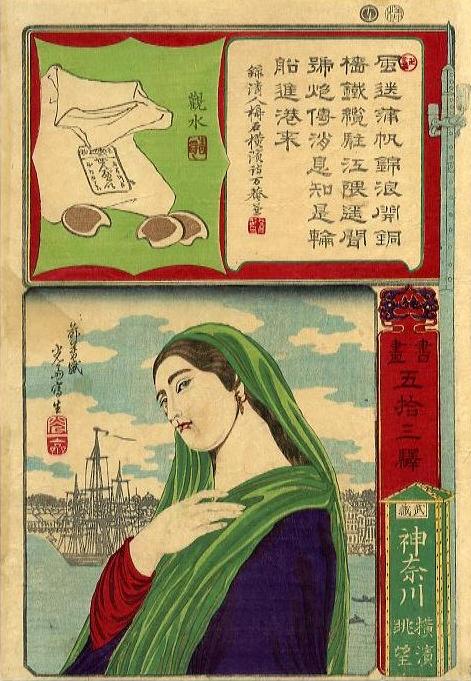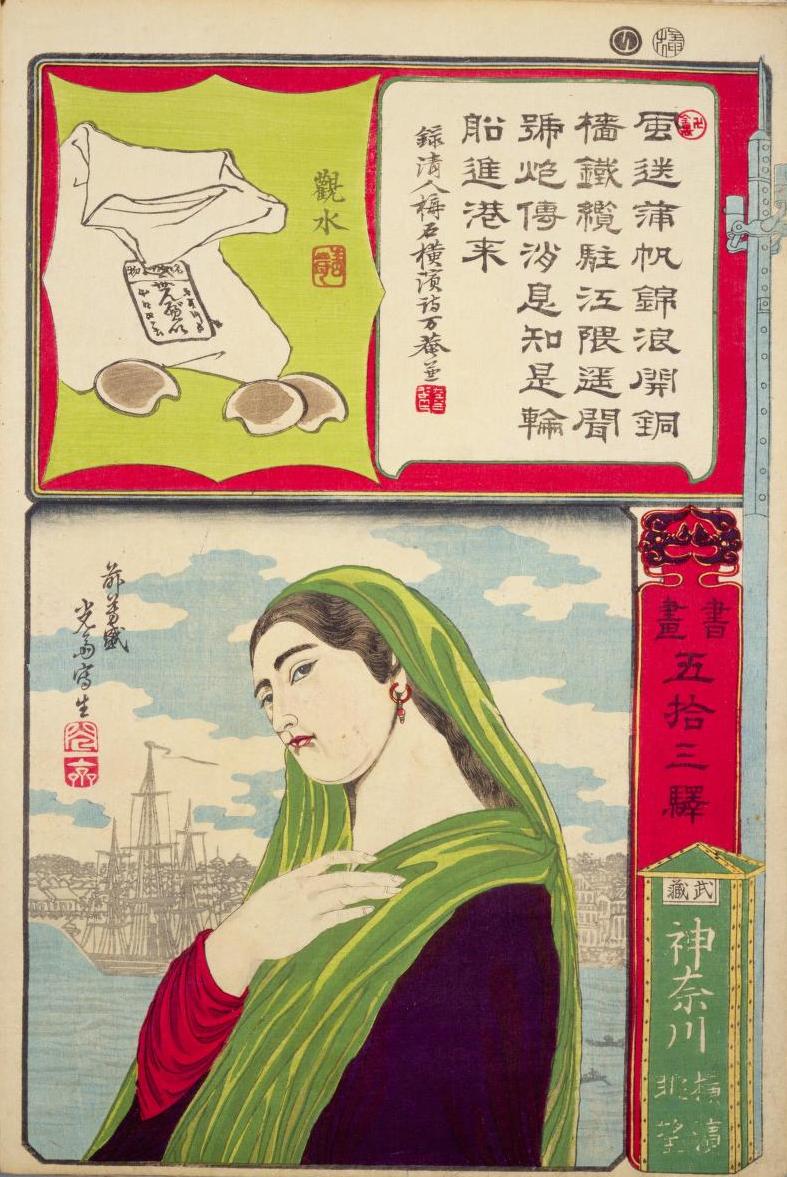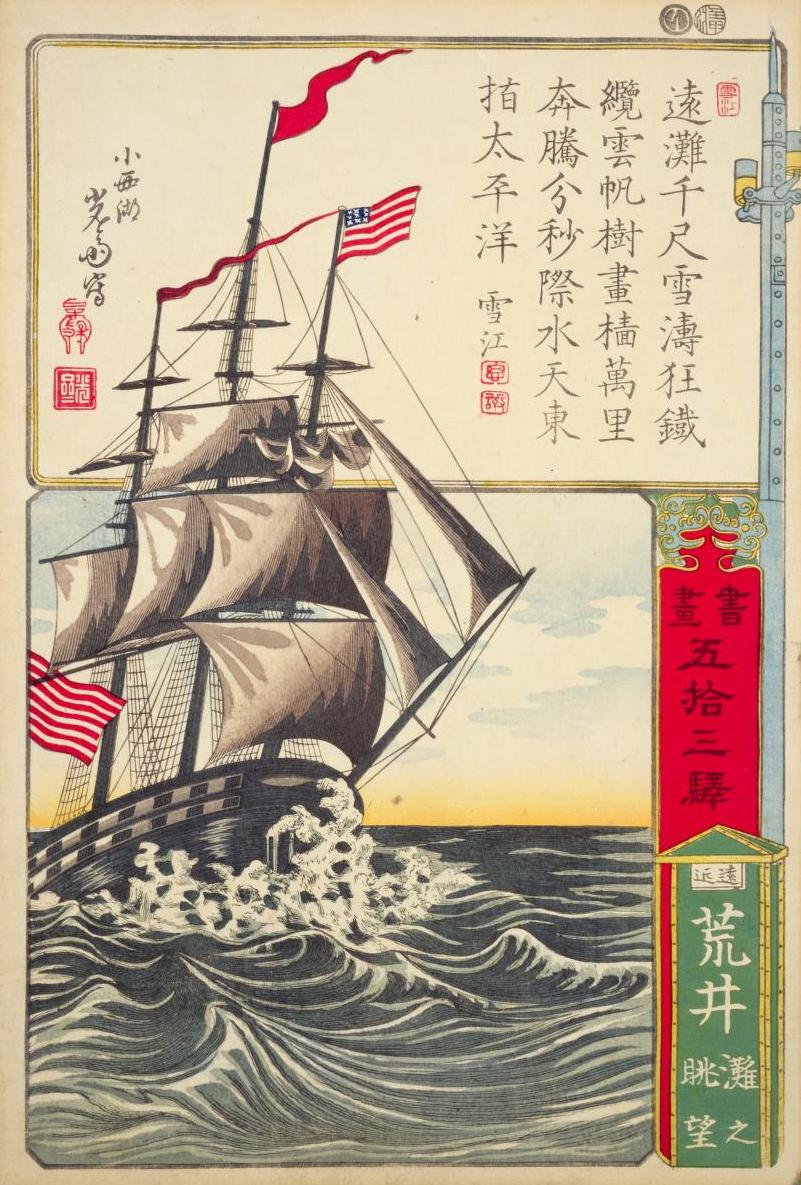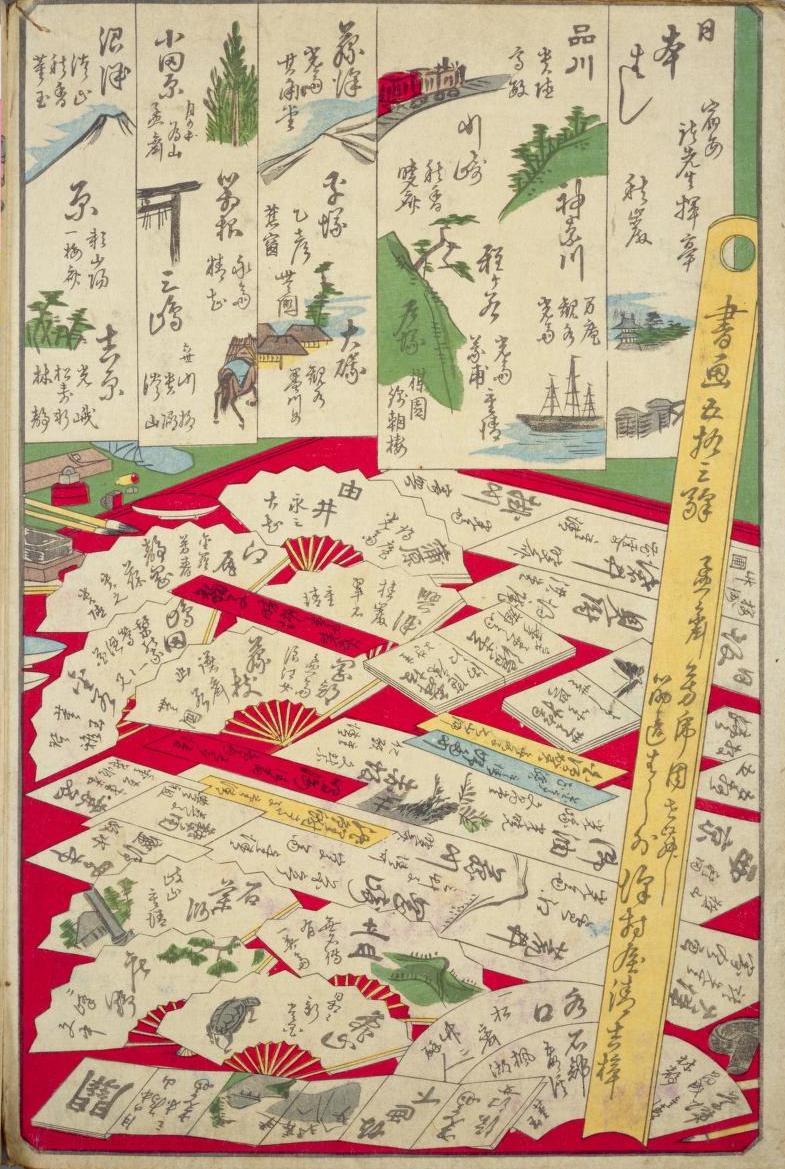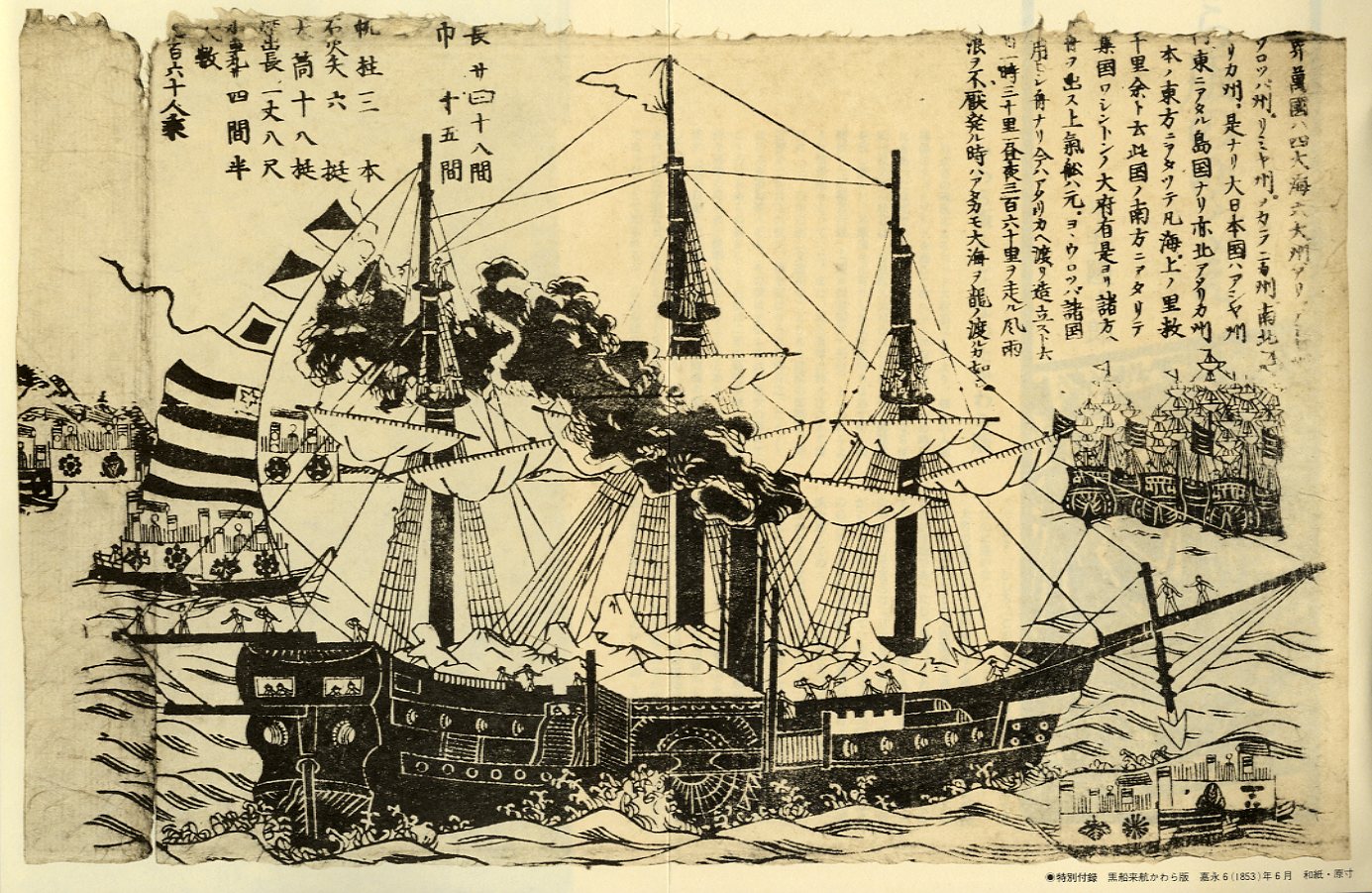|
Meiji 5-10 (November 1872) Musahi / Kanagawa / Yokohama vista The prints to the right are from a series of 55 (or 56) pictures called Shoga gōjūsan eki (書畫五拾三驛) or "Calligraphy and drawings: 53 stations". When sold as a set, the series included a contents sheet (mokuji 目次), which states that the pictures were drawn by Mōsai Yoshitora (孟斎芳虎) and published by Sawamuraya Seikichi (澤村屋清吉). Most of the prints have lunar calendar aratamein (approval seals). And most of the seals are for the 10th month of the 5th year of Meiji, meaning roughly November 1872, just a month before the adoption of the solar calender. Yoshitora, like several of the better known and most productive students of Kuniyoshi (國芳 1798-1861), was active from the late 1850s to the early 1880s. As the principle drawer for the series, his signature appears on 38 prints, in addition to the contents print. The other prints are the works of several other contemporary drawers, including Yoshimori (芳盛 1830-1885), who by then was calling himself Kōsai (光斎). Yoshimori contributed two prints to the series, namely the depictions shown to the right of the woman (SGE-04) and the ship at sea (SGE-33). These two prints stand out as the most distinct in the series, graphically from a stylistic point of view, and narratively in the manner in which the titles given the prints point to the backgrounds of objects that dominate the drawings. Titling the portrait of the woman "Yokohama vista" (SGE-04) and the depiction of the ship as "Vista of the sea" (SGE-33) is tantamount to describing the centerfold of the first issue of Playboy magazine as "Red draping". The particulars of the two prints by Kōsai, and of the contents print, are as follows. SGE-00書画五十三駅 [目次] SGE-04武蔵 / 神奈川 // 横浜眺望 /// 前芳盛 / 光斎写生 SGE-33遠江 / 荒井 // 灘之眺望 /// 小西湖 / 光斎写 NumberingThe prints are not numbered. I have assigned them numbers based on the order of their listing on the contents sheet. The ordering is that of the stages along the route that passed through the Tōkaidō (東海道) or "Eastern Sea Circuit" of Japan from Kantō (Nihonbashi, Shinagawa, Kawasaki, and Kanagawa) to Kansai (Ishibe, Kusatsu, Ōtsu, and Kyōto). SourcesHigh-resolution scans of 55 prints, plus the contents (mokuji) print can be seen at National Diet Library Digital Library (国立国会図書館デジタルコレクション) [National Diet Library Digital Collection]. A list of the prints can also be seen through NDL Search (国立国会図書館サーチ). High-resolution scans of another 55-print collection, though less well-preserved and without the contents sheet, can be seen at Japanese & Chinese Classics (古典籍総合データベース) [Classical Works General Database] at Waseda University Library. |
Kanagawa and Yokohama
Kanagawa station was in town of Kanagawa (神奈川) in the Tachibana district (Tachibana no koori 橘樹郡) of Musashi province (Musashi no kuni 武蔵國). The town was on the bay in the southeast part of the province and centered on the port of Kanagawa (Kanagawa minato 神奈川湊), which was then the most important port in the bay now associated with Yokohama. Nearby Kanagawa Stage (Kanagawa-juku 神奈川宿) is the third stage, beginning with Nihonbashi in Edo, on the conventional list of 53 stages.
Kanagawa is the namesake of the so-called "Kanagawa Treaty" (Kanagawa Jōyaku 神奈川条約), otherwise known as the "Japan-America Amity Treaty" (Nichi-Bei Washin Jōyaku 日米和親条約) among other names. The convention was concluded in the fishing village of Yokohama (Yokohama-mura (横浜村), and the harbor associated with the village was designated as the site of one of the ports at which, under the provisions of the treaty, foreign vessels would be permitted to visit for provisions, repairs, and trade, and where an extraterritorial settlement would be built to accommodate foreign legations, trading companies, and residences.
In 1859, in recognition of Kanagawa's new importance, the Shogunate in Edo established a magistrate's office (bugyōsho 奉行所) in the town to oversee the port and foreign settlement being built at Yokohama. The magistrates office became first Yokohama Court (Yokohama Saibansho 神奈川裁判所) and then Kanagawa Court (Kanagawa Saibansho 神奈川裁判所), and then Kanagawa Office (Kanagawa-fu 神奈川府), all within a few months in the the first half of the 4th year of Keiō (early spring and summer 1868), and a couple of weeks after the start of the Meiji Restoration (fall 1868) it became Kanagawa Prefecture (Kanagawa-ken 神奈川県).
Kanagawa prefecture was created by merging the entirety of Sagami province (相模國) south of Musashi province. Yokohama become its capital.
In 1889, the town of Kanagawa (Kanagawa-machi 神奈川町), enlarged through mergers with a few villages, became part of Tachibana district (Tachibana-gun 橘樹郡), and Yokohama became a city (shi 市). From 1 April 1901, Kanagawa became a neighborhood in Yokohama, and from 1 October 1927 it became Kanagawa ward (Kanagawa-ku 神奈川区). Within 6 decades, the the fishing village of Yokohama had engulfed the larger settlements around it become one of Japan's major metropolises.
Transcription and translation
In the following transcription, I have reproduced the text in the poem using presentday styles of the kanji. I have broken up the stream of kanji into the fourwell as I can using only forms of kanji and kana available in JIS or Unicode. Most of the kanji in the text have furigana readings, but I have omitted these readings in the transcription. I have, however, shown the readings when parenthetically glossing some of the words of interest in the translation.
書畫五十三駅武蔵 神奈川 横濱眺望
風送蒲帆錦浪開 |
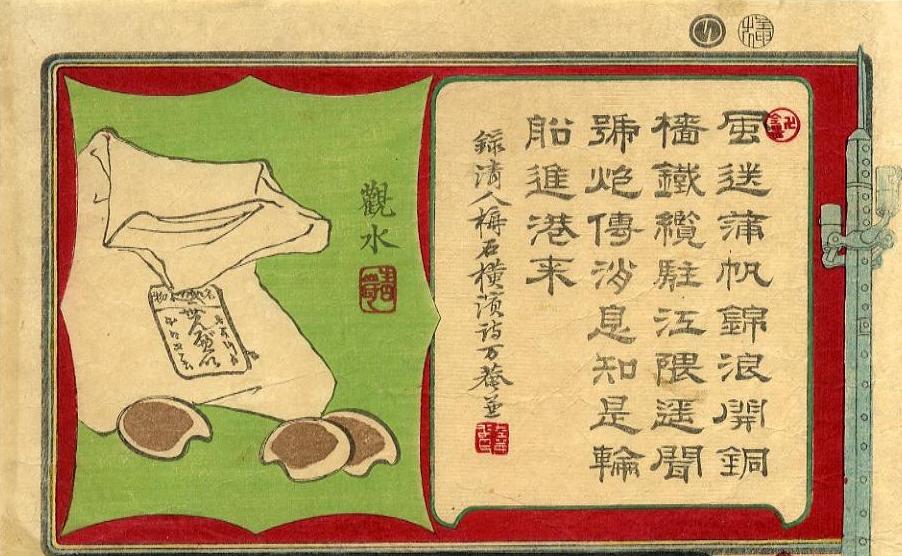 Cartouche from Musashi / Kanagawa / Yokohama chōbō
Cartouche from Musashi / Kanagawa / Yokohama chōbōRight Chinese poem in calligraphy (brusher's name not yet read) Left Bag of senbei, a local specialty (by Kansui) Yosha Bunko scan |
|
CalligraphyThe calligraphy represented on the prints in the SGE series ranges from the classic "reisho" (隷書) or "clerical" style shown here, to the extremely cursive "sōsho" (草書) or "grass" style familiar to students of quickly brushed manuscripts. LineationThe print shows the poem totally unlineated. The reader is expected to recognize that the text is in Chinese, and to know where one line ends and another begins. However, I have transcribed the text as a 7-graph, 4-line stanza, which was one of the most common formats of fixed-meter Chinese poetry. Rush sails and brocade wavesThe fan-like sails are likened to woven rush hence "rush sails" (hoho, gamaho 蒲帆). The choppy waters are colorful hence "brocade waves" (kinpa, nishikinami 錦波). WheelshipsA "wheelship" (rinsen 輪船) was a steam-powered cum sail-blown ship of the kind that populated Commodore Perry's fleet of so-called "blackships" (kurofune 黒船). News of their arrival in 1853 rapidly spread throughout Japan in illustrated woodblock-printed "kawaraban" (かわら版) reports of the kind shown here. |
||
Toshidama Gallery
Toshidama Gallery, an art dealer in the village of Upton Noble, in Somerset, England, sold a copy of this print for 620 pounds at an undisclosed date. The print is hyped -- as many are by sellers of such exotic detritus in Euro-American countries -- as follows (see Distant View of Yokohama and Kanagawa. The italics are as received. The [bracketed] and boxed comments are mine.
Yoshimori, Painting and Calligraphy from the 53 Stations of the Tokaido - Distant View of Yokohama and KanagawaUtagawa Yoshimori (1830 - 1884) Painting and Calligraphy from the Fifty-three Stations of the Tokaido: Distant View of Yokohama and Kanagawa, 1872. Oban. The title signifies "Calligraphy and drawing" in that order -- and this is precisely the order the examples of calligraphy and the drawings appear on the prints, which begins in the upper right corner. The title cartouche signifies a "Yokohama vista" in the Kanagawa area of Musashi province. This print is another iconic image of Meiji Japan. Taken from a series on the 53 Stations of the Tokaido Road that included contributions by other artists including Yoshitora, this is a contemporary account of the great modernisation programme of the Meiji government and is also perhaps a necessary piece of propaganda intended to counter rural superstitions about the unfamiliar course of progress. It was reported that after the introduction of the telegraph into the country, many people complained of foxes knocking in their doors at night delivering false and misleading telegrams. There is no account of the "great modernisation programme" on this print. It merely shows a few elements of local scenery at the time. Yoshitora is billed on the "mokuji" that came with the series of prints if purchased as the drawer of the prints in the series. In fact he contributed some 38 of the 55 prints in the set. There is no foundation for the "perhaps necessary piece of propaganda" speculation. While at times they were didactic, the prints aooear to have been intended mainly as entertainment, not as instruments of disseminating political information, much less personal opinion. There's a lot going on in this print, stylistically and factually, that deserves some attention. Perhaps the most anachronistic image of the piece is the alarming telegraph pole that runs the entire vertical length of the right hand side of the print. This must be one of the earliest renditions of the telegraph in art. The first telegraphic communication wire was installed in 1869 for a distance of about 800m between Yokohama Electric Light Office and Yokohama Courthouse. Telegraphic wire was then installed between Tokyo and Yokohama in December of the same year. In February of 1873, the wire was extended from Tokyo to Nagasaki. This makes this image exactly contemporaneous with that event. The box like object beneath is the way marker for the post station and in the background of the main image there is a view of the harbour at the free trade port of Yokohama containing foreign masted sailing ships. As if to emphasise the modernity, Yoshimori has drawn the figure of the woman in the style of western Renaissance art, making a good comparison a similar print of Kintaro by Yoshitoshi. Both artists were pupils of the great Kuniyoshi who was in the vanguard of experimentation with western styles of drawing. The calligraphy (in Chinese) reads: The telegraph pole was not "anachronistic" but "contemporary" at the time this drawing was printed. By today's standards, everything depicted in the print is "anachronistic" -- even the water and air. There is nothing especially "alarming" about the pole. It is featured on many of the prints in the series. Yokohama was not a "free trade port" but was one of the ports that was officially "open" to foreign vessels. The flow of people and goods into and out of Japan through such ports was overseen and regulated. The woman depicted in the drawing looks nothing like the woman shown with Kintaro in the "similar print" by Yoshitoshi. The wind sends flags and sails in brocade waves/ revealing copper masts and iron hawsers/ It stops in the distance, in the inlet of the bay/ We hear news of its name and its signal fires/ and know that a steamship approaches the harbor. The translation is free in some places and imaginary in others. Published by Sawamuraya Seikichi, signed Zen Yoshimori Kosai shasei. Sold |
Acquisition
I acquired the Yosha Bunko copy of SGE-04 from Gallery Soumei-do (ギャラリーそうめい堂) in Kanda on 6 December 2017. I had not seen it before, possibly because I wasn't paying attention, for 53-stage prints generally bore me. For a print in such a series, however, this one is very unusual, in that it features an almost lifesize drawing of an attractive woman in unusual garp who is all but looking straight at the begetter and otherwise dominating the picture of the view of Yokohama, which becames insignificant.
Print information
Size oban
Drawn by "Former(ly) Yoshimori / Kōsai"
Calligraphy by [unread]
Carved by [unsigned]
Published by Sawamuraya Seikichi [on mokuji]
Aratamein (approval seal) Meiji 5-10 (November 1872)
